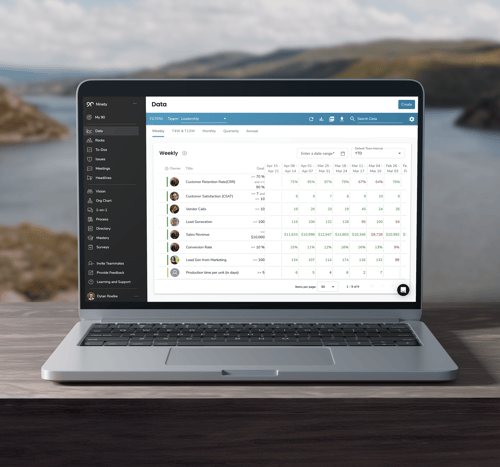How Visionary Leaders Leverage Data to Shape the Future
Over my past four decades as a leader, coach, investor, and entrepreneur, I've witnessed firsthand the exponential growth of data in the business world. Leaders have so much information at their fingertips that it's easy for them to feel overwhelmed. Billions of bytes of digital data are created daily, but it's not just the availability of data that drives businesses to acknowledge its importance. The real motivation lies in the tangible value that data provides for helping organizations gain a competitive advantage by making better-informed decisions, optimizing operations, and enhancing customer experiences.
Data-driven organizations are simply better at tracking and measuring the impact of their decisions, enabling continuous refinement and adaptation to changing circumstances. However, after spending considerable time in various professional settings and working with numerous companies, I've noticed that an overreliance on data can sometimes steer us in the wrong direction.
Before proceeding, however, I believe it's essential to understand the difference between being data-driven and data-informed:
- A data-driven approach relies heavily on data to guide all decisions, often at the expense of other critical factors such as intuition, experience, and context.
- In contrast, a data-informed approach recognizes the value of data but also considers it alongside other crucial elements such as a clear vision, strategic planning, and a deep understanding of the market and Ideal Customers.
The Perils of Overreliance on Data
It’s important to remember that data is just one piece of the puzzle. We must also keep our eyes on the future and contemplate what else is possible. We shouldn’t be stuck in the past, constantly looking over our shoulders. It would be like driving a car and only looking at the rearview mirror — we need to focus on where we want to go, too, not just where we’ve been or what else may be going on around us. Otherwise, we’re still likely to crash. To effectively change outcomes, we need to understand and prioritize the inputs that drive them, focusing on actionable steps to improve these factors. By balancing data-informed insights with a forward-looking, input-focused mindset, we can build more resilient and successful organizations.
This is the issue with relying solely on data: Making decisions based on old information puts us at risk of constantly playing catch-up, following trends that may already be declining. Moreover, data can be downright confusing at times. You can look at the same set of numbers and come up with multiple interpretations, each pointing in a different direction. Ultimately, you may be reluctant to choose any path at all because you’re overwhelmed with conflicting information.
The Vision-Driven Alternative
So, what’s the alternative? Based on what I've seen, we need to have a clear and compelling vision and use data to support it. This means that our vision — which should encompass our Core Values, Ideal Customer, Compelling Value Proposition, and goals — should be the guiding force behind all our actions and decisions. It's our Northern Constellation, a collective beacon of light that guides us through the choppy waters of the business world.
Think of it this way: Your vision is not just a destination — it’s a journey, an ongoing quest to make a difference, to leave your mark on the world. And when everyone in the organization is aligned around that shared vision, incredible things happen. People are inspired to give their best, push past their limits, and contribute to something greater than themselves.

Vision-Driven, Data-Informed Success Story
To better understand how a vision-driven, data-informed approach works in practice, let's look at Ecosia, a B Corporation running a search engine. Ecosia's vision is to use technology to create a more sustainable world by planting trees in areas affected by deforestation. The company uses its ad revenue to fund this mission and tracks the impact of its tree-planting efforts using data.
By measuring key metrics such as the number of trees planted, CO2 removed from the atmosphere, and the benefits for local communities, Ecosia demonstrates the effectiveness of its vision-driven business model. This data-informed approach has allowed Ecosia to expand its reach and impact while remaining true to its Core Values, which are a crucial component of its overall vision.
This is all well and good, you might say. But how do we ensure that becoming vision-driven doesn't lead us to ignore data altogether? Here's the key: We must realize that data is still a valuable tool — it’s just not the only tool in our toolbox. We need to use data to inform and refine our path toward achieving our vision. It can help us spot opportunities, identify areas for improvement, and validate that we're moving in the right direction.
Aligning Your Data Strategy with Your Vision
Another common pitfall for organizations is the tendency to overlook the crucial role that data plays in shaping and aligning their vision. During the early stages of growth, ambitious founders often focus the majority of their time on positioning their product or service as a potential market fit. However, as the company matures, it's crucial to allocate more time and resources to turning the original vision into reality.
This is where data comes into play.
By setting company key performance indicators (KPIs) that demonstrate progress toward your vision, you can ensure that everyone is aligned and focused on the critical numbers that demonstrate growth and resilience, rather than just reporting on past performance. These KPIs should include finance-based metrics like revenues and profits, marketing-based metrics like companies in trial, and operations-based metrics like the number of Ideal Customers or the percentage of orders shipped on time.
For example, say your company has a Compelling and Audacious Goal (CAG) of being the most customer-centric brand in your industry. To support this objective, you decide to track various touch points across website interactions, product usage, and customer support. By regularly monitoring and analyzing this data, your company can identify areas where you need to improve the customer experience and make intentional choices to address any issues. This approach helps you stay true to your CAG, using data to inform and guide your efforts while keeping your vision at the forefront.
My big point here is this: turning your vision into reality unquestionably hinges on data and its correct use. Without a forward-looking, vision-aligned perspective on data, companies are more likely to get sidetracked and lose momentum or worse, veer off track. By aligning data strategies with a strong and compelling vision, organizations can not only unite their teams but also spark creativity and innovation in service of their vision. Leveraging data to guide, assess, and validate the organization's direction enables leaders to make more informed decisions and monitor progress toward achieving their long-term goals. What’s more, taking a data-informed, vision-driven approach will maximize the likelihood that you and your team are building a great organization where employees are focused, aligned, thriving, and invested in the company's vision.
Charting Your Vision-Driven, Data-Informed Future
As we enter into this New Age of Work, where technology plays an increasingly vital role in every business, ambitious founders should embrace vision-driven, data-informed approaches. Here’s how you can get started:
- Clarify your company's vision. Ensure it is clear, compelling, and widely understood across the organization.
- Set KPIs and targets that directly support your long-term vision.
- Foster a data-informed culture. Encourage employees at all levels to use data to inform their decisions and actions, always keeping the larger vision in mind.
- Continuously review and refine. Regularly assess your approach to mastering your organization's data competency, making adjustments as needed to maintain alignment with your vision.
As your company continues to grow and evolve through the Stages of Development, your approach to leadership must adapt accordingly. This means thinking and acting at higher levels of complexity while focusing more and more on the long-term vision.
The Power of a Shared Vision
When a company is truly vision-driven, something amazing happens: The vision transforms beyond mere words on a page. It becomes a living, breathing part of the organization's DNA. It influences every choice, every interaction, and every offering.
Think about some of the most iconic companies out there — the ones that have not only survived but thrived over decades. What sets them apart? It's not just their products or market dominance — it's their unwavering commitment to their vision, which encompasses a core set of guiding principles, values, and beliefs. These companies excel at inspiring their Ideal Stakeholders — teams, customers, partners, investors, and so on — with a sense of purpose and mission that transcends short-term gains by leveraging data to assess progress and long-term impact.
The power of a shared vision is what keeps an organization united and drives it forward. When this vision is informed by data, blending reality with creative possibilities… when an organization is on the path to becoming an excellent company where everyone can focus, align, and thrive… That's when the real magic happens.
Building a great company is never easy — nothing worthwhile ever is. But if we stay true to a vision, use data wisely and well, and never lose sight of the impact we want to make, we can achieve extraordinary things.





